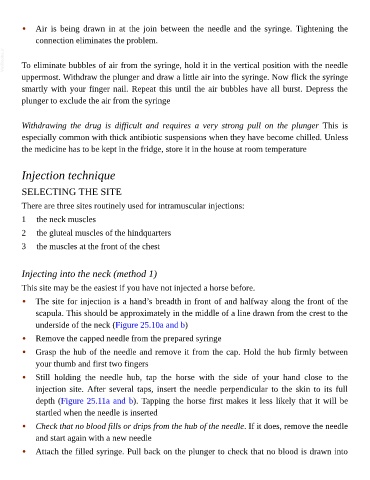Page 1130 - The Veterinary Care of the Horse
P. 1130
• Air is being drawn in at the join between the needle and the syringe. Tightening the
connection eliminates the problem.
VetBooks.ir To eliminate bubbles of air from the syringe, hold it in the vertical position with the needle
uppermost. Withdraw the plunger and draw a little air into the syringe. Now flick the syringe
smartly with your finger nail. Repeat this until the air bubbles have all burst. Depress the
plunger to exclude the air from the syringe
Withdrawing the drug is difficult and requires a very strong pull on the plunger This is
especially common with thick antibiotic suspensions when they have become chilled. Unless
the medicine has to be kept in the fridge, store it in the house at room temperature
Injection technique
SELECTING THE SITE
There are three sites routinely used for intramuscular injections:
1 the neck muscles
2 the gluteal muscles of the hindquarters
3 the muscles at the front of the chest
Injecting into the neck (method 1)
This site may be the easiest if you have not injected a horse before.
• The site for injection is a hand’s breadth in front of and halfway along the front of the
scapula. This should be approximately in the middle of a line drawn from the crest to the
underside of the neck (Figure 25.10a and b)
• Remove the capped needle from the prepared syringe
• Grasp the hub of the needle and remove it from the cap. Hold the hub firmly between
your thumb and first two fingers
• Still holding the needle hub, tap the horse with the side of your hand close to the
injection site. After several taps, insert the needle perpendicular to the skin to its full
depth (Figure 25.11a and b). Tapping the horse first makes it less likely that it will be
startled when the needle is inserted
• Check that no blood fills or drips from the hub of the needle. If it does, remove the needle
and start again with a new needle
• Attach the filled syringe. Pull back on the plunger to check that no blood is drawn into

